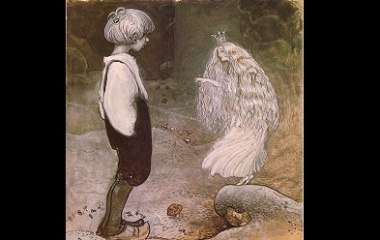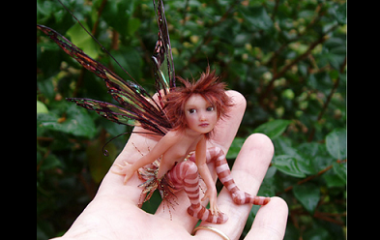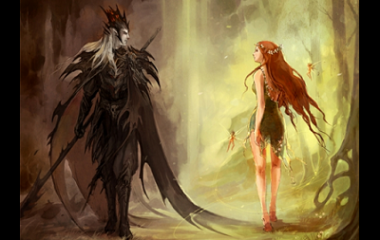Take a walk along England’s beautiful southern coast and you may be charmed by more than just pretty wildflowers, mystical stone rings, and the blue, blue ocean. Pixies also roam the countryside, and if you happen to have a pretty scrap of ribbon or a clever verse of poetry for them, they might just invite you to join in with one of their giddy dances or send you along your way with a blessing over your head.
What Are Pixies?
Pixies are wee, magical creatures who throw merry parties and shower blessings across the English countryside, especially in Devon and Cornwall. They are beloved for their childlike appearance and bubbly spirits, even though they do play the occasional prank on travelers.
Characteristics
Physical Description
As a rule, Pixies are very small. In some stories, they are so tiny that they can sit in your palm or rest under the shade of a mushroom. In other stories, they are larger, but they rarely reach the height of a human’s knee.
Their skin may be flesh-colored, blue, or green. Their eyes and ears are slightly pointed, and they have lovely wings, resembling a butterfly or dragonfly.
Although the little people aren’t particularly good at making clothing (if left to their own devices, they go around naked or clad in rags), they do love fine things, and they will seize upon any gift of beautiful clothing that is offered to them.
Special Abilities
Pixies may be small, but they are rich in magical power. They often use their powers to bring a smile to the face of a human friend; as one popular poem describes, “All human ills they can subdue / Or with a wand or amulet / Can win a maiden’s heart for you / And many a blessing know to stew.”
The little people have a special talent for casting charms that affect human behavior. They can enchant children and beautiful maidens into joining one of their dances, or they can muddle travelers and cause them to wander for miles in the wrong direction.
Nature can also fall under the spell of these merry little creatures. Plants grow more quickly, flowers blossom more brightly, and wild animals are tame when they are nurtured by Pixies. The little people have a soft spot for horses; they enjoy making nests in the horses’ manes and hitching a ride around the countryside, which they are fond of exploring.
Homes
Although adventurous and fond of exploring, Pixies are also very attached to their homes. If there is a way to provoke the wrath of these happy-go-lucky little people, it is to threaten their homes, which they have defended from monks and fairies on numerous occasions.
Pixies are concentrated in southern England, especially in Devon and Cornwall. According to early folklore, they live in ancient underground locations, which usually have some connection to their ancestors. These may be barrows (mounds of earth covering a burial ground) or stone rings.
More recently, folklore has moved the little people into cozier abodes. They are now said to live in hollowed trees or stumps, complete with miniature windows and gardens.
Related Creatures
Pixies are commonly confused with fairies, but they are not the same at all. In fact, folklore contains many stories about conflicts between fairies and Pixies, primarily involving fairies who try to invade the Pixies’ homelands in Devon and Cornwall.
There are several important differences between fairies and Pixies. In early legends, fairies are often malicious, while Pixies are kind, with the occasional fit of mischief. Fairies are said to be spawned by nature spirits, while Pixies are more often regarded as close relatives of humans.
Sprites are also swapped out with Pixies in today’s vocabulary, but in original folklore, they were two separate creatures. While Pixies are meadow and woodland creatures, sprites need to spend time near the water. Sprites are harmless as far as humans are concerned, but they certainly aren’t as friendly as Pixies.
Cultural Representation
Origin
Although some scholars trace the etymology of the word Pixie back to a Swedish word that means “wee little fairy,” most people agree that the little people are probably Celtic in origin. Indeed, the culture of southern England was shaped heavily by the Celts, and Celtic folklore contains some creatures who, while unlike the Pixie in name, are a lot like him in appearance and habits.
Famous Folktales
The folklore of southern England is full of the antics of Pixies. They go merrymaking with the village folk, mischief monks, and even fraternize with King Arthur and Santa Claus. A large sample of their stories can be found in Peter and the Piksies: Cornish Folk and Fairy Tales, an anthology of Cornish folklore by Ruth Manning-Sanders.
Perhaps the most famous folktale featuring the little people is the story of “The Three Little Piksies,” which gained worldwide fame as “The Three Little Pigs.”
Modern Literature
Pixies have undergone a lot of changes since the days when they dwelled under the barrows and stone rings of old England. Today, they are more mischievous than ever, and they are less distinguishable from fairies and sprites.
Pixies step into the spotlight in the popular fantasy series, Artemis Fowl, where they are childlike, temperamental villains who live underground. They also make a famous appearance in Harry Potter and the Chamber of Secrets, where they are small, bright blue, pesky creatures.
Explanations of the Myth
Some scholars believe that Pixie folklore is, in fact, based on a real, ancient race of people who lived in or near southern England. The Pict tribe, famous for their blue war paint, are often pointed to as “real life Pixies,” but the theory is undermined by the fact that the Scottish tribe was located a good distance from Devon and Cornwall. Other scholars believe that a race of pygmy people might have lived on the islands off the coast of Southern England.










